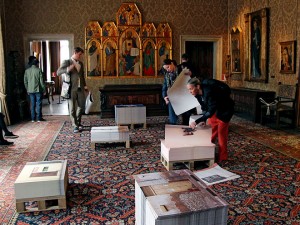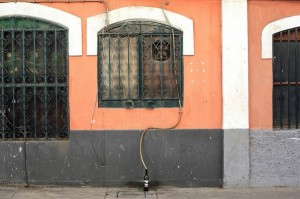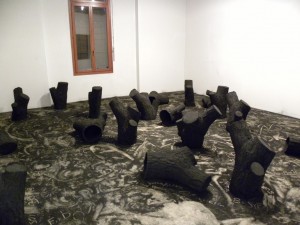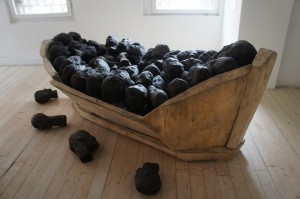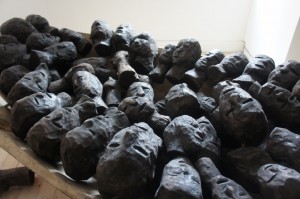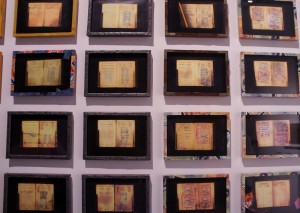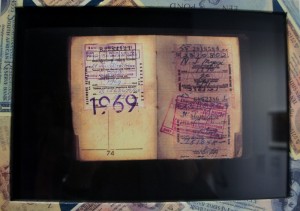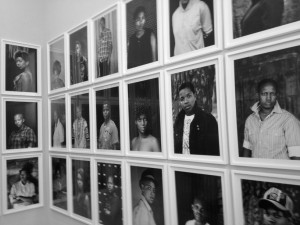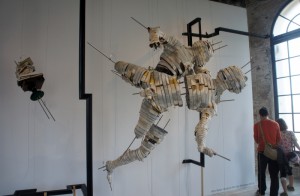“A Mad Dash through the African Pavilions at the Venice Biennale” by Pamela Allara
I am thrilled to offer you today my first Guest Blogger
African Art Specialist Pamela Allara, Ph.D. with an overview of
the African Art Pavilions at the Venice Biennale
This year’s Venice Biennale was one of the best I have ever seen, and I have gone intermittently since 1964 when the U.S. pavilion, featuring Robert Rauschenberg , won the Golden Lion award. Since at least 1907, a major section of the highly-regarded survey of contemporary art has been exhibited in pavilions representing individual nations. With the exception of the U.S. pavilion, the nations were European, and the exhibition as a whole completely Eurocentric.
When at last in 2007 Simon Njami and Fernando Alvim introduced contemporary African art for the first time, the exhibition was unfortunately continent-wide, reinforcing the regrettable mind-set that Africa is a single country. On the upside, national African participation has grown since then, and this year, for the 55th Biennale–“Il Palazzo Enciclopedico” (June 1-November 24, 2013)–one could encounter diverse and sophisticated exhibits in five African national pavilions: Angola, Ivory Coast, Kenya, Zimbabwe and South Africa. Moreover, one of the first-time participants, Angola, won the Golden Lion for Best National Participation.
One strategy adopted by the Biennale’s Director, Massimiliano Gioni, was to create a series of exhibitions so vast as to demonstrate his central thesis that no one intellectual or spiritual system could possibly hope to encompass the vast diversity of the world in which we live. The result was that the visitor was required to run an art marathon, dashing through individual installations and pavilions that were various approaches to the encyclopedic theme, in a desperate attempt to take in as much as possible.
In the rush, I made a number of facile judgments, one of which was a negative assessment of the Angola’s “Luanda: Encyclopedic City,.” (see top of post). Housed in the splendiferous Palazzo Cini, normally closed to the public, the installation of stacks of photocopied street photographs by the young artist Edson Chagas created a marked contrast with the gorgeous, gold-framed Medieval and Renaissance paintings on the walls. Initially, the juxtaposition evoked the inevitable cliché the national pavilions in the Giardini had for so long reinforced: the extraordinary achievement of Western European culture vs. the pitiful backwardness of African society. In addition, I did not find the concept of purchasing the photographs for one Euro each especially original; and at least in the past the stacked papers in various exhibits by the Cuban-born artist Félix González-Torres (d. 1996) could be carried home for free.
However, after returning the States, I reconsidered my initial impressions of the decisions made by curators Paula Nascimento and Stefano Raboli Pansera. (Their interview on the Biennale website is well worth a visit here. Rather than a clichéd contrast between the ‘West’ and the ‘Third World’, one could consider the installation a demonstration of the entanglement of richer and poorer nations in the global capitalist system, with its vast dispersion of people and goods. In that context, it was fitting that viewers were invited to participate by parting with their own money. And kudos are due to the curators for selecting a young, relatively unknown artist for this first venture onto the Biennale’s international art stage.
In the photographs in Chagas’ Found Not Taken series (fig. 2), abandoned objects are repositioned within public spaces, encouraging the viewer to imagine potential narratives for the discards, while acknowledging that the potential stories of those objects could be endless.
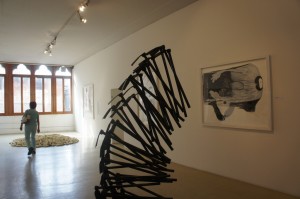
Zimbabwe pavilion with drawing by VIrgina Chihota on the wall and two parts of an installation by Michaele Mathison called Landscape
As for the other pavilions, I will provide only a brief summary here: Zimbabwe avoided that nation’s harsh political realities by including in its very professional installation five outstanding artists whose concerns were primarily spiritual: Rashid Jogee, Portia Avavahera, Virginia Chihota (above, the drawing), Voti Theve, and Michele Mathison ( the installation).
Another first-time exhibitor, the Republic of the Ivory Coast, was also impressive. Curated by Yacouba Konaté, “Traces and Signs” led the viewer into its representation of this West African nation with the familiar but always delightful work of Frédéric Bruly Bouabré, who was also included in the main exhibit in the Arsenale. However, this viewer’s ‘prize’ went to the sculptor Jems Robert Koto Bi, whose ambitious sculptures were so evocative of emigration and displacement.
A bit of context is needed before turning to Kenya. A secondary theme of the Biennale was the negation of its founding concept of art as expressive of a national culture, the concept enshrined in the Giardini’s national pavilions. In response to the globalism of contemporary art, France and Germany decided to switch venues, inducing immediate shock in the viewer. (France in the echt Fascist architecture of the German pavilion???) Moreover, Germany’s untitled exhibit in France’s pavilion contained only one German artist. South Africa’s Santu Mofokeng was included, with a strong selection of his haunting landscapes, as was Ai Wei Wei and Danita Singh. So, just as a handful of African countries were finally granted their own national pavilions, the exhibit as a whole was undercutting the very idea of nationhood.
Unfortunately, the Kenyan pavilion fell afoul of that internal contradiction. Perhaps in an attempt to appear forward-looking and sophisticated, the curators decided to jump on the ‘global’ bandwagon; in the exhibition, “Reflective Nature,” 8 out of the 11 artists were Chinese, and only two were Kenyan. With no context provided for the curious curatorial decisions, the exhibition was completely incoherent, generating much negative commentary on the internet. In Kenya’s defense, it is important to recognize that the idea of a national pavilion for non-western countries was a losing battle from the outset. The Giardini pavilions represent ‘the West’; set in back of the Arsenale or scattered around the city, the other, small, hard-to-find national pavilions were ‘the rest.’ It will be interesting to see what happens at the 56th Biennale.
Because my area of curating and writing is South African art, I will close with some brief observations about the exhibition, “Imaginary Fact: Contemporary South African Art and the Archive.” Initially, it was one of disappointment. As curated by Brenton Maart, it examined the trend in contemporary art to re-write history through re-presenting and reinterpreting existing archives. Obviously, this effort is especially pertinent to South Africa, where the examination of historical records, both written and material, is crucial to the process of creating new histories by unearthing overlooked or censored materials. The great variety of approaches found in the works of the 13 artists and one trio of collaborators from South Africa tended to dilute this concept, or at least suggest its increasing trivialization over time.
One of the first, and now iconic, archival investigations, is Sue Williamson’s For thirty years next to his heart, created in 1990, the year Mandela was released from prison, (fig. 4). With a grouping of 49 color laser prints, Williamson reproduces every page of Mr. John Ngesi’s dompass, the ‘dumb pass,’ required of non-whites for proof of residence, clearance for work, and taxes. Donated to the artist by Ngesi, it is now part of Williamson’s personal archive of apartheid, and it remains a powerful witness of the warping of identity by an oppressive bureaucracy,(fig. 4 a).
Around the corner from this riveting if familiar work was an installation by Joanne Bloch, currently a doctoral candidate at the Centre for Curating the Archive and The Archive and Public Culture Initiative at the University of Cape Town. (The curator is in the same program). In Hoard, (2012-13; fig. 5), the artist stocked a glass museum case with simulated rare objects such as the miniature gold Mapgunubwe scepter together with a recreated wooden block from her childhood; the juxtaposition attempted to “throw into question the categories of ‘real’ and ‘fake;…and take a stab at disturbing established or expected systems of classification.,” according to her artist statement. I found the installation obvious to the point of being facile, but to be fair, time constraints did cause me to rush to judgment.
If Bloch’s examination of the idea of the archive did not “allow the artist to create work with the potential to change the course of our contemporary world,” according to the curatorial essay, the contemporary archive created by documentary photographer Zanele Muholi indeed has demonstrated that potential. Her Faces and Phases series consists of black and white portraits of the LGBTI community in South Africa, and have been exhibited in major exhibitions globally. Installed salon-style along a narrow corridor, the viewer was confronted with individuals whom one could neither enumerate nor typecast. In that constricted space the viewer was denied a distanced gaze, and encouraged to feel a sense of solidarity with a group that has been “so far violently and blaringly erased,” in the artist’s words. Last year, Muholi’s flat was broken into and 20 hard drives containing over six years of work were stolen. But by now her very personal archive is sufficiently public—both in museums and online—that it cannot be erased.
Although the compressed space worked to Muholi’s advantage by briefly including the viewer in her community, it put much of the rest of the work at a disadvantage. One exception was the sculpture of Wim Botha, who was provided with a sort of mini-retrospective of work from 2009 to 2013.
One installation, humanoid figures constructed from books, and battling in mid-air, summed up the controversies over meaning that have characterized South Africa’s post-apartheid investigations of identities and histories. In an enlightened decision, the excellent catalogue has been made available for downloading from the exhibition website.
This cursory introduction will not be the last word on the African pavilions at the Biennale—at least I hope not. More time is needed to digest these exhibits. The Biennale itself was so sprawling that it has spawned ‘discussion groups’ in my greater Boston neighborhood where we share information, and hopefully, insights. That we would meet and debate in such post-exhibition sessions is indicative of something I can’t quite articulate: was this the Salon des Refusées of
- the 21st century?
This entry was posted on November 25, 2013 and is filed under Art and Politics Now, art criticism, Uncategorized, Venice, Venice Pavilion.

